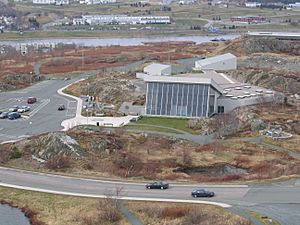Johnson Geo Centre facts for kids
 |
|
| Established | 2002 |
|---|---|
| Location | 175 Signal Hill Road St. John's, Newfoundland and Labrador A1A 1B2 |
| Type | geological interpretation centre |
The Johnson Geo Centre is a super cool science center in St. John's, Newfoundland and Labrador, Canada. It's built right into Signal Hill! This special place helps you learn all about Earth's geology, from rocks and mountains to volcanoes and even space. It opened in 2002 and is named after a kind person named Paul Johnson.
Contents
A Building Inside a Hill
Most of the Johnson Geo Centre is actually built underground. It's dug into a natural rock formation left behind by glaciers! This design lets you see the real bedrock of Signal Hill right inside the building.
The building was carefully planned to show off the amazing geology of Signal Hill. It was built in a spot that used to be filled with peat (a type of soil). Workers removed the top layers of soil to reveal the ancient rock. Then, a special glass building, about 2.5 stories tall, was built on top of this excavated area.
The Johnson Family Foundation helped pay for the center, which cost about $11 million. The building also uses a smart heating and cooling system. It has six special wells that go 500 feet deep into the ground. These geothermal wells use the Earth's natural heat to keep the building comfortable.
What You Can Explore
At the Johnson Geo Centre, you can travel through 3.7 billion years of Earth's history! You'll learn about amazing topics like:
- How continents move around the Earth (called continental drift)
- How huge glaciers shaped the land
- What causes earthquakes and volcanoes
The center also has exhibits about space. You can explore our solar system and learn about the universe beyond Earth.
Johnson Geo-Vista Park
Outside the main building, there's a lovely area called the Johnson GEO-VISTA Park. This park has eight walking trails that loop around the Geo Centre. As you walk, you'll see outdoor displays that explain:
- The local rock formations
- Different types of plants that grow there
- How people in Newfoundland and Labrador traditionally used stone
The park was finished in 2007. It even includes a replica of an old root cellar, a graveyard, and a house chimney, all showing how stone was used long ago. The trails in the Geo Park connect to the Grand Concourse walkway system, which is a big network of trails in St. John's.
Images for kids
-
This shows the Upper Precambrian Gibbett Hill Formation. It's a greenish-gray rock made of sandstone, siltstone, and tuff.
See also
 In Spanish: Centro Johnson Geo para niños
In Spanish: Centro Johnson Geo para niños





